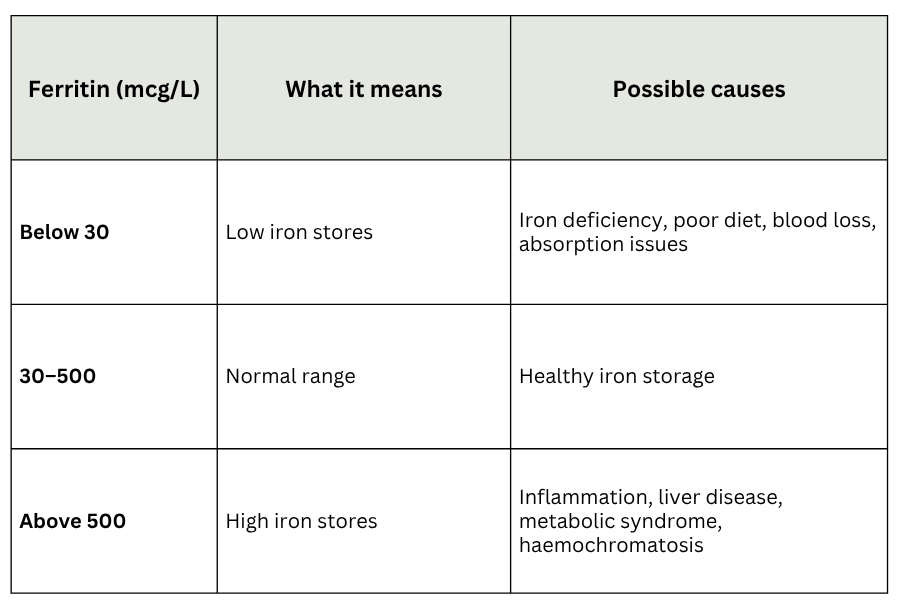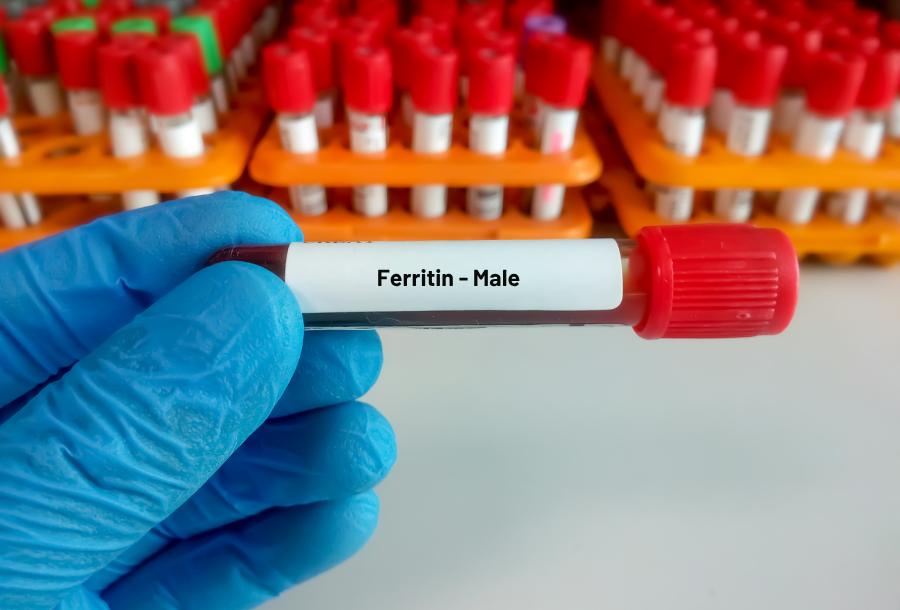Limited time: Save $400+ on a range of tests
Choose how you’d like to begin
CGM program
Optimise metabolism in real time with sensors

Advanced Blood Test
Get your baseline health report and personalised plan




Ferritin is a protein that stores iron in the body, and a ferritin male blood test in Australia measures how much iron is available in reserve. Unlike standard iron tests, ferritin reflects long-term iron storage and can also rise in response to inflammation, making it an important marker of both iron balance and overall health.
Low ferritin levels are often linked to fatigue, poor sleep initiation, restless legs syndrome, and reduced cognitive function, even when haemoglobin is normal. High ferritin, on the other hand, may signal inflammation or underlying conditions.
This guide explains what it is, how it works, what your results mean, and how you can book a comprehensive blood test to check your ferritin male.
Ferritin is a special protein in your body that stores iron, much like a savings account keeps money safe until you need it. When your body requires iron to make red blood cells or carry oxygen, ferritin releases it. A ferritin male blood test in Australia shows how much iron is tucked away in storage, giving doctors a clearer picture than just checking iron levels in the blood.
For men, ferritin levels are especially important because both low and high levels can affect energy, brain function, and overall health. Too little ferritin may cause tiredness, poor sleep, and restless legs. Too much ferritin can point to inflammation or conditions that affect metabolism.
Quick facts about ferritin in men:
In simple terms, ferritin tells you whether your iron “bank account” is running low, just right, or overfilled.
Ferritin male reflects your iron reserves — the fuel for oxygen transport, cellular energy, muscle performance, and brain function. Balanced ferritin supports metabolism and longevity; too little can drive fatigue, poor concentration, restless legs, and lowered immunity, while persistently high levels can signal inflammation or metabolic and liver stress.
Iron-related problems are common globally. The Global Burden of Disease analysis estimates anaemia affected about 24.3% of people in 2021, underscoring how widespread iron imbalance remains.
Australian guidance also places ferritin at the centre of assessment: low ferritin is diagnostic of absolute iron deficiency, and serum iron alone shouldn’t be used. Moreover, ferritin behaves as an acute-phase reactant — it can rise with inflammation — so context matters when interpreting results.
The empowering part: a simple ferritin male blood test can reveal hidden deficits or excesses early, guiding targeted nutrition, lifestyle, or medical care to support your energy, cognition, and long-term metabolic health.
You may want to consider a ferritin male blood test if you experience symptoms or risk factors linked to iron imbalance or inflammation. Common scenarios include:
Testing ferritin male can help uncover hidden imbalances early, giving you the chance to take proactive steps for better health.
In Australia, the ferritin male blood test is usually ordered by your GP or specialist as part of iron studies or pathology panels. You visit a pathology collection centre (often affiliated with providers like Sonic, iMedical, or state pathology services).
You typically don’t need to fast for ferritin alone, though if the doctor orders a wider panel (e.g. lipids, glucose) they may ask you to fast.
If your GP refers you and the test is eligible under the Medicare Benefits Schedule (MBS), you may receive a rebate. For example, the MBS Item 66596 covers iron studies including ferritin — the schedule fee is AUD 32.55, with Medicare paying 75% (or 85% in some cases) of that.
If you order privately (self-request or through a private health clinic), the ferritin test cost Australia is higher. An iron studies panel (which includes ferritin) can cost around AUD 75 in some labs. Some private providers bundle tests without Medicare rebates.
Ferritin male is often included in broader panels (e.g. “iron studies”, “full health check”) combining markers like haemoglobin, CRP, liver function, and more. These panels are available via GP request or direct-access in private labs.Results are usually returned in 24–72 hours.
In summary, in Australia you can access a ferritin male test either through Medicare-rebated GP referrals or privately (with higher cost), and it’s commonly bundled into comprehensive tests to provide fuller insight into your iron and metabolic health.
Ferritin male results show how much iron your body has stored. Interpreting the numbers is important because both low and high levels can affect your energy, metabolism, and overall health. While ferritin is a reliable marker of iron status, it can also rise if your body has inflammation, which is why doctors often look at it together with other markers such as CRP and ESR.
Here’s a simple guide to understanding your results:

If your results are outside the healthy range, your GP may recommend further testing or treatment. For example, low ferritin can occur even if haemoglobin is normal, and high ferritin may need to be checked alongside markers like liver function tests and kidney markers.
Looking at ferritin male alongside related biomarkers such as haemoglobin, CRP, and liver enzymes gives a clearer picture of your overall health.
Ferritin male is most useful when interpreted with other blood markers. On its own, it reflects stored iron, but because ferritin can also rise with inflammation or liver stress, additional tests provide a clearer picture.
Common markers that help give context include
Looking at ferritin male alongside these markers ensures results are accurate and meaningful, helping guide the right medical or lifestyle steps.
Your ferritin male levels can be shaped by daily habits around food, movement, rest, and stress. Making small, steady changes helps maintain balance and overall health.
These are supportive steps, not medical advice. The best starting point is testing — once you know your levels, you can take personalised steps.
A ferritin male blood test measures the amount of iron stored in your body. It helps detect iron deficiency, iron overload, or inflammation that may affect your health.
If ordered by a GP and covered under Medicare, there is usually no out-of-pocket cost. Private self-request tests can range from about $30 to $75 depending on the provider.
Yes. If your doctor provides a referral, ferritin testing is generally included under the Medicare Benefits Schedule, meaning little or no direct cost to you.
In most cases, yes. A GP referral ensures Medicare coverage. Some private labs allow self-request, but you’ll need to pay the full test fee.
Doctors may recommend this test if you have fatigue, restless legs, poor sleep, or abnormal blood results. It also helps monitor chronic conditions like liver or kidney disease.
Yes. Iron needs rise during pregnancy, so checking ferritin helps ensure both mother and baby have adequate iron stores to reduce risk of complications.
In adult men, the typical reference range is around 30 to 500 mcg/L. Values below or above this may require further investigation by your doctor.
Ferritin male is a crucial marker of how much iron your body has in reserve. It provides insights that go beyond a standard iron test, highlighting whether low stores may be contributing to fatigue, restless legs, or poor sleep, or if high levels are linked to inflammation or metabolic concerns. By understanding your ferritin, you gain a clearer picture of your energy, resilience, and long-term health.
Testing gives you the knowledge to act early. Whether through nutrition, lifestyle changes, or medical care, knowing your ferritin levels allows you to make informed decisions that support better wellbeing. Knowledge truly is empowering, helping you address problems before they become harder to manage.
Take control of your health today. Sign up for our comprehensive blood test and get clear insights into your ferritin male and more than 50 other key markers.
Subscribe to our newsletter & join a community of 20,000+ Aussies

Ferritin is a protein that stores iron in the body, and a ferritin male blood test in Australia measures how much iron is available in reserve. Unlike standard iron tests, ferritin reflects long-term iron storage and can also rise in response to inflammation, making it an important marker of both iron balance and overall health.
Low ferritin levels are often linked to fatigue, poor sleep initiation, restless legs syndrome, and reduced cognitive function, even when haemoglobin is normal. High ferritin, on the other hand, may signal inflammation or underlying conditions.
This guide explains what it is, how it works, what your results mean, and how you can book a comprehensive blood test to check your ferritin male.
Ferritin is a special protein in your body that stores iron, much like a savings account keeps money safe until you need it. When your body requires iron to make red blood cells or carry oxygen, ferritin releases it. A ferritin male blood test in Australia shows how much iron is tucked away in storage, giving doctors a clearer picture than just checking iron levels in the blood.
For men, ferritin levels are especially important because both low and high levels can affect energy, brain function, and overall health. Too little ferritin may cause tiredness, poor sleep, and restless legs. Too much ferritin can point to inflammation or conditions that affect metabolism.
Quick facts about ferritin in men:
In simple terms, ferritin tells you whether your iron “bank account” is running low, just right, or overfilled.
Ferritin male reflects your iron reserves — the fuel for oxygen transport, cellular energy, muscle performance, and brain function. Balanced ferritin supports metabolism and longevity; too little can drive fatigue, poor concentration, restless legs, and lowered immunity, while persistently high levels can signal inflammation or metabolic and liver stress.
Iron-related problems are common globally. The Global Burden of Disease analysis estimates anaemia affected about 24.3% of people in 2021, underscoring how widespread iron imbalance remains.
Australian guidance also places ferritin at the centre of assessment: low ferritin is diagnostic of absolute iron deficiency, and serum iron alone shouldn’t be used. Moreover, ferritin behaves as an acute-phase reactant — it can rise with inflammation — so context matters when interpreting results.
The empowering part: a simple ferritin male blood test can reveal hidden deficits or excesses early, guiding targeted nutrition, lifestyle, or medical care to support your energy, cognition, and long-term metabolic health.
You may want to consider a ferritin male blood test if you experience symptoms or risk factors linked to iron imbalance or inflammation. Common scenarios include:
Testing ferritin male can help uncover hidden imbalances early, giving you the chance to take proactive steps for better health.
In Australia, the ferritin male blood test is usually ordered by your GP or specialist as part of iron studies or pathology panels. You visit a pathology collection centre (often affiliated with providers like Sonic, iMedical, or state pathology services).
You typically don’t need to fast for ferritin alone, though if the doctor orders a wider panel (e.g. lipids, glucose) they may ask you to fast.
If your GP refers you and the test is eligible under the Medicare Benefits Schedule (MBS), you may receive a rebate. For example, the MBS Item 66596 covers iron studies including ferritin — the schedule fee is AUD 32.55, with Medicare paying 75% (or 85% in some cases) of that.
If you order privately (self-request or through a private health clinic), the ferritin test cost Australia is higher. An iron studies panel (which includes ferritin) can cost around AUD 75 in some labs. Some private providers bundle tests without Medicare rebates.
Ferritin male is often included in broader panels (e.g. “iron studies”, “full health check”) combining markers like haemoglobin, CRP, liver function, and more. These panels are available via GP request or direct-access in private labs.Results are usually returned in 24–72 hours.
In summary, in Australia you can access a ferritin male test either through Medicare-rebated GP referrals or privately (with higher cost), and it’s commonly bundled into comprehensive tests to provide fuller insight into your iron and metabolic health.
Ferritin male results show how much iron your body has stored. Interpreting the numbers is important because both low and high levels can affect your energy, metabolism, and overall health. While ferritin is a reliable marker of iron status, it can also rise if your body has inflammation, which is why doctors often look at it together with other markers such as CRP and ESR.
Here’s a simple guide to understanding your results:

If your results are outside the healthy range, your GP may recommend further testing or treatment. For example, low ferritin can occur even if haemoglobin is normal, and high ferritin may need to be checked alongside markers like liver function tests and kidney markers.
Looking at ferritin male alongside related biomarkers such as haemoglobin, CRP, and liver enzymes gives a clearer picture of your overall health.
Ferritin male is most useful when interpreted with other blood markers. On its own, it reflects stored iron, but because ferritin can also rise with inflammation or liver stress, additional tests provide a clearer picture.
Common markers that help give context include
Looking at ferritin male alongside these markers ensures results are accurate and meaningful, helping guide the right medical or lifestyle steps.
Your ferritin male levels can be shaped by daily habits around food, movement, rest, and stress. Making small, steady changes helps maintain balance and overall health.
These are supportive steps, not medical advice. The best starting point is testing — once you know your levels, you can take personalised steps.
A ferritin male blood test measures the amount of iron stored in your body. It helps detect iron deficiency, iron overload, or inflammation that may affect your health.
If ordered by a GP and covered under Medicare, there is usually no out-of-pocket cost. Private self-request tests can range from about $30 to $75 depending on the provider.
Yes. If your doctor provides a referral, ferritin testing is generally included under the Medicare Benefits Schedule, meaning little or no direct cost to you.
In most cases, yes. A GP referral ensures Medicare coverage. Some private labs allow self-request, but you’ll need to pay the full test fee.
Doctors may recommend this test if you have fatigue, restless legs, poor sleep, or abnormal blood results. It also helps monitor chronic conditions like liver or kidney disease.
Yes. Iron needs rise during pregnancy, so checking ferritin helps ensure both mother and baby have adequate iron stores to reduce risk of complications.
In adult men, the typical reference range is around 30 to 500 mcg/L. Values below or above this may require further investigation by your doctor.
Ferritin male is a crucial marker of how much iron your body has in reserve. It provides insights that go beyond a standard iron test, highlighting whether low stores may be contributing to fatigue, restless legs, or poor sleep, or if high levels are linked to inflammation or metabolic concerns. By understanding your ferritin, you gain a clearer picture of your energy, resilience, and long-term health.
Testing gives you the knowledge to act early. Whether through nutrition, lifestyle changes, or medical care, knowing your ferritin levels allows you to make informed decisions that support better wellbeing. Knowledge truly is empowering, helping you address problems before they become harder to manage.
Take control of your health today. Sign up for our comprehensive blood test and get clear insights into your ferritin male and more than 50 other key markers.
Get irrefutable data about your diet and lifestyle by using your own glucose data with Vively’s CGM Program. We’re currently offering a 20% discount for our annual plan. Sign up here.

Discover how controlling your glucose levels can aid in ageing gracefully. Learn about the latest research that links glucose levels and ageing, and how Vively, a metabolic health app, can help you manage your glucose and age well.


Delve into the concept of mindful eating and discover its benefits, including improved glucose control and healthier food choices. Learn about practical strategies to implement mindful eating in your daily life.


Understand the nuances of polycystic ovary syndrome (PCOS) testing in Australia, the importance of early diagnosis, and the tests used to effectively diagnose the condition. Also, find out when these diagnostic procedures should be considered.
